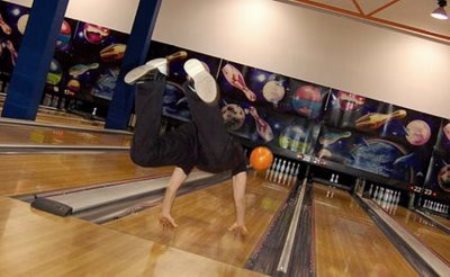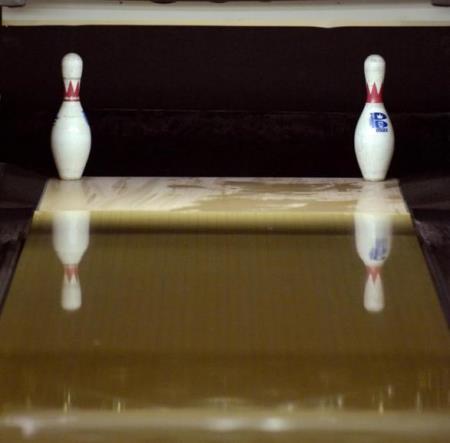Making In-Game Adjustments
Making In-Game Adjustments
In every sport, teams and players have to make adjustments during the game based on what their opponent is doing. Bowling is no different…except that the opponent is not another team or player. It’s the OIL PATTERN! As your game progresses, the oil pattern will change. If you understand this concept, you’re going to perform head and shoulders above others who don’t.

Sometimes even the bowler helps move the lane oil.
By now, you should be able to get lined up using the tools we’ve provided you in past articles. If not, go back and study! And if you don’t have your own custom ball by now, you should probably get one (we've explained the reasons here).
But how do you stay lined up when the shot changes? Let’s lay-out some of the strategies for overcoming this invisible, but intimidating opponent.
Move in the direction of the miss
The first rule of bowling adjustments is you do not talk about bowling adjustments. Wait, that’s not right. The first rule of bowling adjustments is that you move in the direction of the miss while keeping the same target on the lane. This means that if your ball misses to the left of the intended destination, move left on the approach. If the ball misses to the right of the intended destination, move right on the approach. Easy enough, right? Learn this rule and never forget it.
Make angular and parallel adjustments
Lane conditions change as bowling balls repeatedly travel down the lane. With each shot, the ball absorbs some of the oil and moves some oil farther down on the lane. Changes in the oil distribution will affect ball path and reaction.
There are two primary adjustments you can make to continue hitting the pocket: angular and parallel.
Angular adjustments
An angular adjustment, as shown below, is a common move to adapt to changing lane conditions. For example, you may start your bowling session standing on the 20th board and aiming at the 10th board (2nd arrow). As the lanes start to hook more, you might move your starting position one board to the left but keep your target the same. This is a slight angular adjustment. But what if you need to move more?

Are you ready for the second rule of bowling adjustments? The second rule of bowling adjustments is you DO NOT talk about bowling adjustments. No? OK. Another thing to keep in your bowling memory bank is 2 and 1. The 2-and-1 rule for making angular adjustments means that for every two boards you move with your feet, you move your target one board in the same direction. Using the starting point example we just used (20th board), a 2-and-1 adjustment would have you stand on the 22nd board and aim at the 11th board. This rule is especially helpful when you need to make a move more than one or two boards.
Parallel adjustments
If an angular adjustment just isn’t working, try making a parallel adjustment. A parallel adjustment, as shown below, is made when both your target on the lane and your starting position move the same amount and in the same direction. If you move right two boards with your feet, move right two boards with your target.

Adjust your target backward and forward
Another way to get the ball to the pocket is fine-tuning the shape of your ball path.
If your ball is not hooking or not hooking soon enough, aim at a target closer to the foul line and in front of the arrows. This will cause you to lay the ball down earlier and the ball will hook earlier. Conversely, if your ball is hooking too soon, choose a target farther down the lane. This will get you to extend through the shot and the ball will hook less.
Eliminating corner pins
You just rolled one of the best shots of your life. It left your hand and you said to yourself, “Yeah, that’s going to strike.” But somehow, the 10 pin didn’t get the message because it’s still standing. While this is incredibly frustrating, it’s going to happen…a lot. No matter how good you are, you’re going to leave your fair share of corner pins. Don’t get frustrated. Let's take a look at why this happens and what we can do about it.

These pins are the enemy. Let's get rid of them.
As we just mentioned in the situation above, one of the most common spares for a right-hander is the 10 pin. For a perfect strike, the ball hits the 1-3 pocket and continues through to the 5 and 9 pins. The 3 pin is driven into the 6 pin and the 6 pin hits the 10 pin. Now, if the 10 pin is still standing, you need to find out where the 6 pin went. Did it get driven straight back to where the 9 pin stands? Or is it lying dead in the right side gutter? Let’s break down these two scenarios and find out how to fix them.
If the 6 pin is going straight back and missing the 10 pin to the left, it means you are hitting “high” on the head pin. The 3 pin has too much angle on the 6 pin and is causing it to fall straight back instead of at an angle into the 10 pin. Try moving your feet slightly to the left and keeping the same target or move your target farther down the lane.
If the 6 pin is going into the right gutter, it means you are hitting “light” in the pocket. The 3 pin does not have enough angle into the 6 pin and it is missing the 10 pin to the right. Try moving your feet slightly to the right and keeping your same target or move your target closer to you and in front of the arrows.
The scenario is the same for left-handers who leave the 7 pin, but on the opposite side. The direction of the 4 pin is the key to finding out why the hit wasn't perfect.
Congratulations!
At this point, you can pretty much handle anything the lane throws at you. While it’s not as easy as it sounds, with some practice you’ll be making these adjustments without having to think twice. And once you’ve mastered them and outsmarted the oil, go ahead and talk some trash. Just don’t let anybody else see you talking trash to nobody because that’s just weird.





